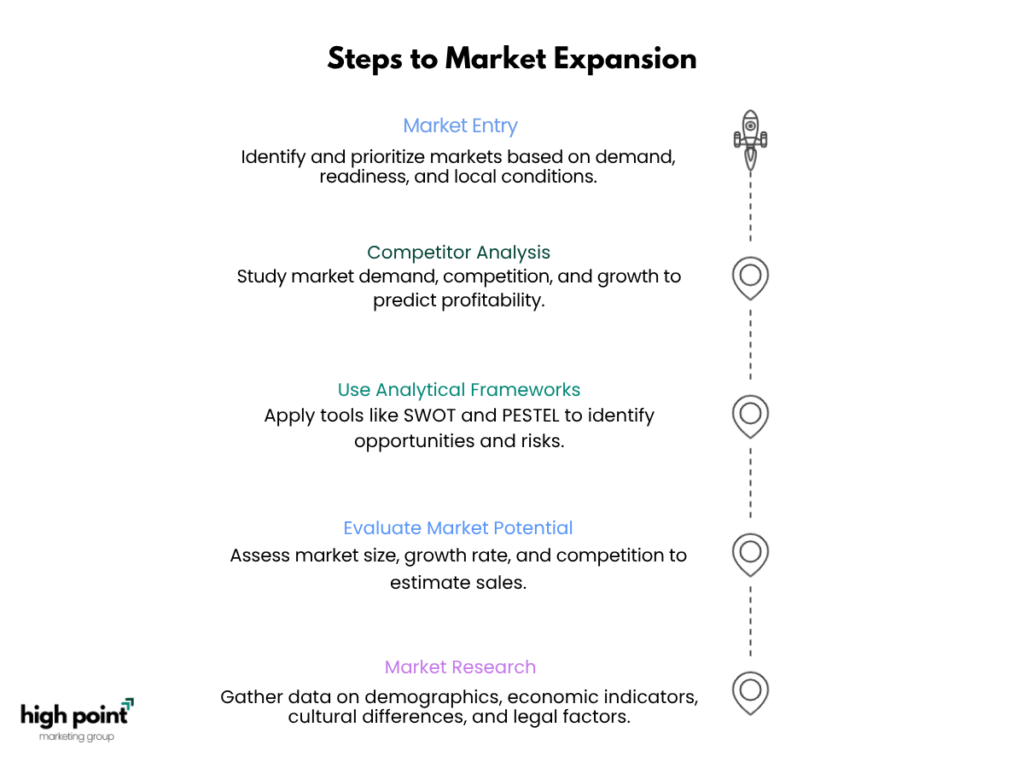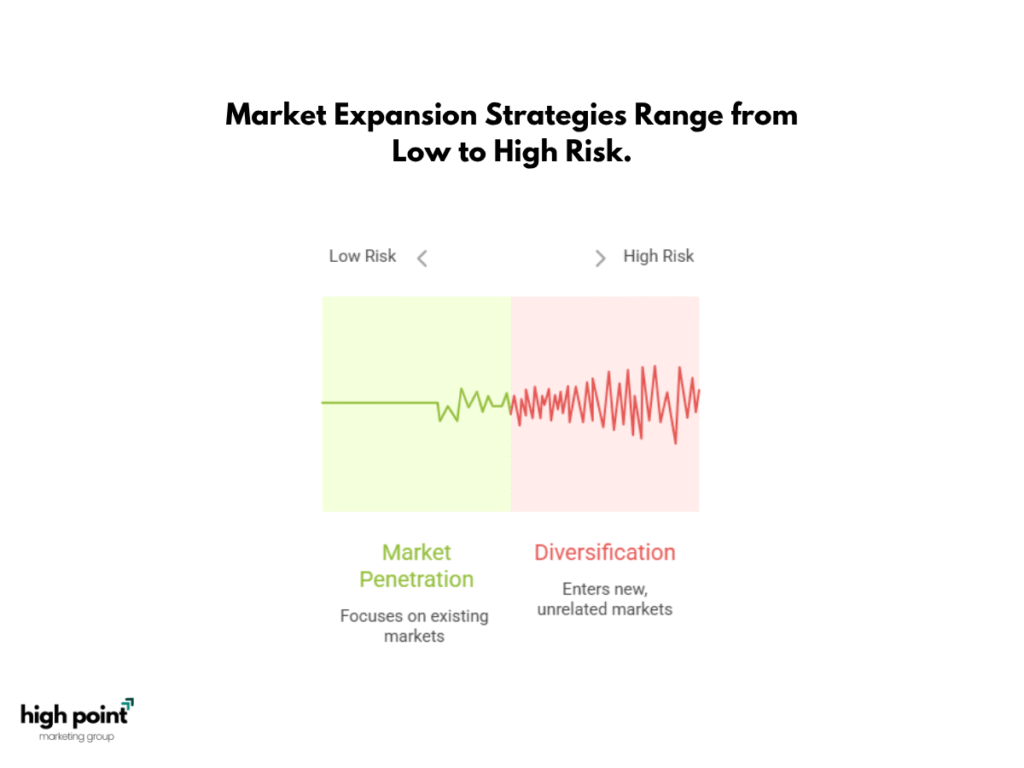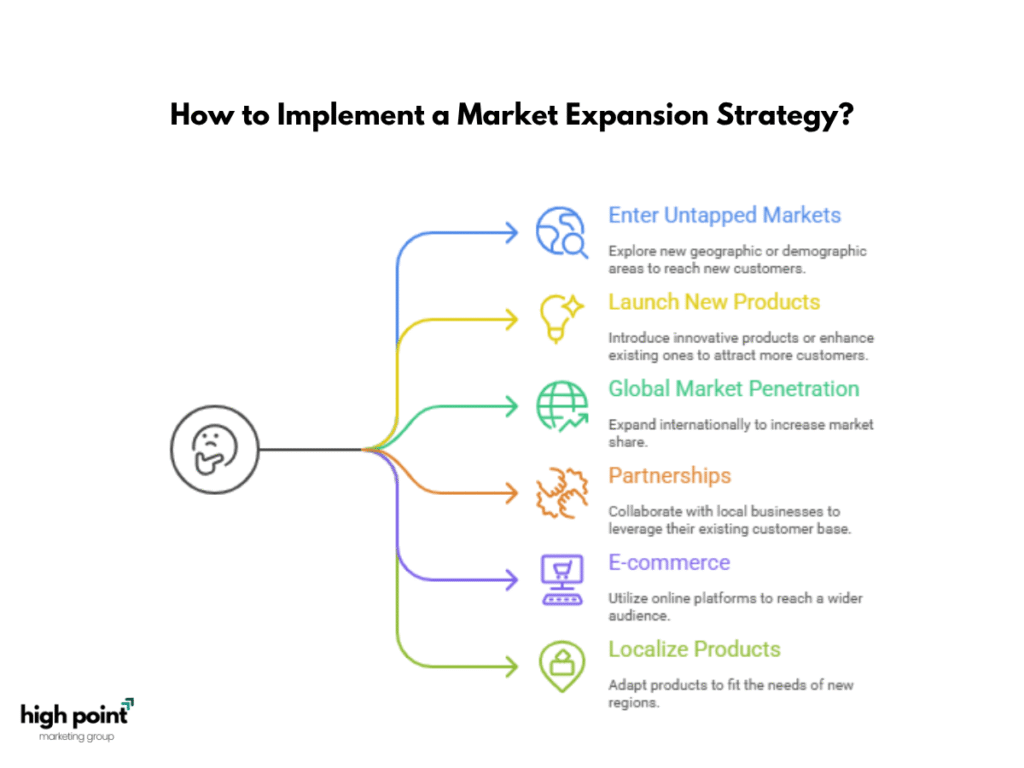What is a Market Expansion Strategy?
A market expansion strategy is a growth approach where businesses enter new markets to increase revenue. It helps companies find untapped opportunities and expand their customer base. Research shows that businesses with such strategies are 30% more likely to grow sustainably (Park Avenue Capital, 2025). A similar concept is market development, which targets new markets for existing products. Companies use this strategy to boost sales and stay competitive. Originating from Ansoff’s Matrix (1957), it includes geographic expansion, product diversification, and demographic segmentation.
What are the Four Primary Types of Market Expansion Strategy?
The Four Primary Types of Market Expansion Strategies help businesses grow by targeting new markets or product offerings:
- Market Penetration: Increasing sales of existing products in existing markets.
- Market Development: Introducing existing products into new markets or customer segments.
- Product Development: Creating new or improved products for current or new markets.
- Diversification: Entering new markets with new products, which may be related or completely different.
These strategies aim to increase market share and revenue, often used when existing markets are saturated or growth opportunities are limited. Successful expansion requires market research and strategy alignment.

How Does a Market Expansion Strategy Differ From Market Penetration?
A Market Expansion Strategy targets new markets or customer segments, while Market Penetration focuses on increasing sales within existing markets. Market expansion is generally riskier and more aggressive.
- Market Penetration: Increases sales of existing products within current markets to gain a larger market share.
- Market Expansion: Introduces existing products into new markets or segments for growth.
Goal: Penetration maximizes growth in existing markets; expansion seeks growth through new markets.
Risk: Penetration is a lower risk, while expansion carries a higher risk due to unfamiliar markets.
How Does a Market Expansion Strategy Inform a Plan?
A Market Expansion Strategy guides a business plan by outlining how to enter new markets and increase revenue. It helps define goals, target regions, and operational needs for growth.
Key Points:
- Goal: Increase market share and revenue in new regions.
- Benefits: Risk diversification, access to new markets, and cost reductions.
- Considerations: Requires understanding local cultures, conditions, and regulations.
The strategy shapes the plan by setting clear expansion objectives and is used when domestic growth opportunities are limited.

How Does a Market Expansion Strategy Identify Market Opportunities?
A market expansion strategy is a structured approach that enables businesses to identify and assess opportunities in new or untapped markets, thereby driving growth and increasing revenue. Here are the key ways in which such a strategy identifies market opportunities:
- Market Research:
Conducting thorough market research is essential. This includes understanding current trends, customer needs, and the competitive landscape of potential markets (Park Avenue Capital, 2025). - Evaluating Market Size and Growth Potential:
A crucial aspect of identifying opportunities is evaluating the size of a potential market and its growth rate. A market with high growth potential can offer substantial long-term benefits (Park Avenue Capital, 2025). - Consumer Segmentation and Behavior:
Understanding how different consumer segments behave and aligning those behaviors with your products can reveal new expansion opportunities (Euromonitor, 2025). - Competitive Landscape Analysis:
Analyzing the competitive environment helps businesses spot gaps or unmet needs in the market. This allows companies to position themselves strategically by offering unique or improved products or services (Technorely, 2024). - Focusing on Adjacent Markets:
Many businesses expand by entering adjacent markets—markets that are related to their current offerings but present new growth opportunities. These markets typically involve less risk than entirely new, uncharted markets (Weitnauer Group, 2024). - Geographical Expansion:
Expanding into new geographical territories, including international markets, can open up new customer bases and revenue streams. Understanding the dynamics of these markets is key to finding the right expansion opportunities (Velocity Global, 2024). - Identifying Emerging Markets:
Businesses often look to emerging markets characterized by growing economies and untapped demand. These markets are prime candidates for expansion as they offer substantial potential for growth (Boom and Bucket, 2023). - Market Opportunity Analysis:
A market opportunity analysis assesses market conditions, competition, and customer demand to identify areas for growth (Smartling, 2025). - Entry Strategies:
An effective market expansion strategy includes entry strategies such as prioritizing regions, developing a step-by-step entry approach, and scaling operations gradually to maximize success (Lokalise, 2024).
By focusing on these strategies, businesses can identify lucrative markets that align with their capabilities, helping them grow and expand sustainably.

How Does a Market Expansion Strategy Analyze Market Potential?
A market expansion strategy aims to grow a business by increasing its market share, customer base, and revenue through entering new or expanding existing markets. To analyze market potential, the strategy follows these key steps:
- Market Research: Gather data on demographics, economic indicators, cultural differences, and legal factors. (Source: Locize)
- Evaluate Market Potential: Assess the market’s size, growth rate, and competition to estimate possible sales. (Source: Shopify, Acquire.com)
- Use Analytical Frameworks: Tools like SWOT and PESTEL help identify opportunities and risks. (Source: gigCMO)
- Competitor and Market Size Analysis: Study market demand, competition, and growth to predict profitability. (Source: FasterCapital)
- Market Entry: Identify and prioritize markets based on demand, readiness, and local conditions. (Source: Metheus, MotionPoint)
This process ensures businesses can effectively assess and expand into new markets.

How Does a Market Expansion Strategy Prioritize Target Markets?
A market expansion strategy prioritizes target markets to focus resources on the most profitable opportunities. Key steps include:
- Market Size and Growth: Assess each market’s potential based on its size and projected growth.
- Accessibility: Assess entry barriers, such as logistics and regulations.
- Strategic Fit: Ensure the market aligns with your product and capabilities.
- Demand and Competition: Analyze demand and the competitive landscape.
Focus on markets with long-term growth potential and scalability, while balancing immediate opportunities with sustainable growth.

How is a Market Expansion Strategy Executed?
Executing a market expansion strategy involves several key steps:
- Market Research: Understand the target market’s needs, trends, and competitors.
- Product Development: Tailor your product to the new market.
- Set Up Distribution Channels: Ensure efficient logistics for product availability.
- Launch Marketing Campaigns: Create demand and build brand awareness.
- Monitor Performance: Track KPIs to assess success and make adjustments.
Successful execution requires clear goals, efficient logistics, and targeted marketing efforts to meet market demands.

What are Examples of a Market Expansion Strategy?
Examples of a Market Expansion Strategy
- Geographic Expansion: Entering new regions, like a North American smartphone company expanding into Asia or McDonald’s opening locations in new countries.
- Demographic Expansion: Targeting new customer segments, such as a clothing brand that appeals to both young adults and older consumers.
- Product Innovation: Launching new products or improving existing ones, like Lululemon expanding its athleisure products in the Asia Pacific market.
- Strategic Partnerships: Expanding through joint ventures or franchising, as seen with Starbucks entering new markets with localized offerings.
- Acquisitions: Acquiring local companies to leverage their established market presence.
These strategies help businesses reach new markets and drive growth.
What Defines a Successful Global Market Expansion Strategy?
A successful global market expansion strategy involves setting clear goals, conducting thorough market research, and adapting to local markets. Key elements include:
- Clear Goals: Define objectives like increasing revenue or enhancing brand presence.
- Market Research: Understand local competition, consumer behavior, and regulations.
- Localization: Adapt products and marketing to local preferences.
- Strategic Planning: Develop a detailed entry strategy with timelines.
- Local Partnerships: Collaborate with local businesses to ease market entry.
These elements ensure successful global expansion.

What Challenges Can Impact a Market Expansion Strategy?
What Challenges Can Impact a Market Expansion Strategy?
Expanding into new markets presents several challenges:
- Cultural Differences: Adapting to local cultural preferences and behaviors.
- Regulatory Barriers: Navigating complex legal and compliance issues.
- Economic Instability: Risks from currency fluctuations and political instability.
- Logistical Challenges: Issues with shipping, customs, and supply chain management.
- Competition: Competing with established local businesses.
Careful planning and adaptation are essential to overcome these challenges.
Strategic Planning and Consulting Services
Need help with market expansion? Our strategic planning and consulting services can guide you. Discover more at High Point Marketing Group Strategic Planning Consulting.
How is Risk Level Used to Select a Market Expansion Strategy?
Risk level determines the approach a business takes in expanding to new markets. Key points include:
- Risk Quantification: Assessing risk likelihood and impact helps prioritize markets.
- Strategy Type: Low-risk strategies like market penetration are used for stable markets, while high-risk strategies like diversification target higher returns.
- Risk Tolerance: Businesses with higher risk tolerance choose more aggressive, volatile markets.
- Market Research: Thorough research helps assess risks such as political instability or currency fluctuations.
- Risk Mitigation: Diversification spreads risk across regions or products.
These factors help businesses align expansion strategies with their risk appetite and objectives. Risk evaluation in the Ansoff Matrix

What Role Does Vertical Integration Play in a Market Expansion Strategy?
Vertical integration helps companies control multiple supply chain stages, enhancing efficiency, reducing costs, and strengthening market presence. It also allows businesses to manage risks better and enter new markets more effectively.
Key Facts:
- Control and Efficiency: Streamlines operations, reduces costs, and improves market operations. (Source: Investopedia)
- Market Presence: Strengthens market position and deters competition. (Source: Beyond Esade)
- Risk Management: Reduces dependency on external suppliers and mitigates supply chain risks. (Source: Unleashed Software)
- Competitive Advantage: Facilitates market entry, economies of scale, and protection of proprietary processes. (Source: Medium)
- Strategic Expansion: Companies like Tesla use it to scale efficiently in new markets. (Source: Wall Street Prep)

How do Different Businesses Use a Market Expansion Strategy?
Market expansion is a growth strategy that businesses use to increase market share, reach new customers, and expand operations by entering new or existing markets. Here’s how businesses implement it:
- Types of Expansion:
- Enter untapped markets
- Launch new products or improve existing ones
- Strategic Approaches:
- Global Market Penetration: Expanding internationally
- Partnerships: Collaborating with local businesses
- E-commerce: Utilizing online platforms for wider reach
- Sector-Specific Strategies:
- SaaS: Use partnerships or new product offerings to expand.
- Small Businesses: Localize products to fit new regions.
- Benefits:
- Reach new customers
- Increase revenue
- Lower unit costs through scale
Successful market expansion involves selecting the right markets, tailoring strategies, and adjusting products to meet new customer needs.

How do Retailers Grow By Using a Market Expansion Strategy?
Retailers grow by using market expansion strategies to increase their presence and market share through:
- Opening new store locations
- Entering new markets (geographic or demographic)
- Expanding product ranges or introducing new products
- Utilizing digital sales channels (e-commerce platforms). Market Expansion Strategies in Wikipedia
Key Benefits:
- Increased brand visibility and customer base
- Revenue growth through product diversification
- Risk reduction by entering new, untapped markets
Retailers need to understand local customer preferences and competition, developing tailored strategies for each new market to ensure success.

What Characterizes a Growth Opportunity for a Market Expansion Strategy?
A growth opportunity for a market expansion strategy arises when a business can increase its reach, revenue, or diversify by entering new markets or customer segments. Key characteristics include:
- New Markets: Expanding into untapped or underserved regions.
- Product Diversification: Introducing new products to attract different customer segments.
- Geographic Expansion: Entering new areas to reduce market saturation risks.
- Targeting Untapped Customer Segments: Reaching new demographics for growth.
Additionally, businesses should consider market saturation, competitive advantage, and cultural fit to ensure successful expansion.
